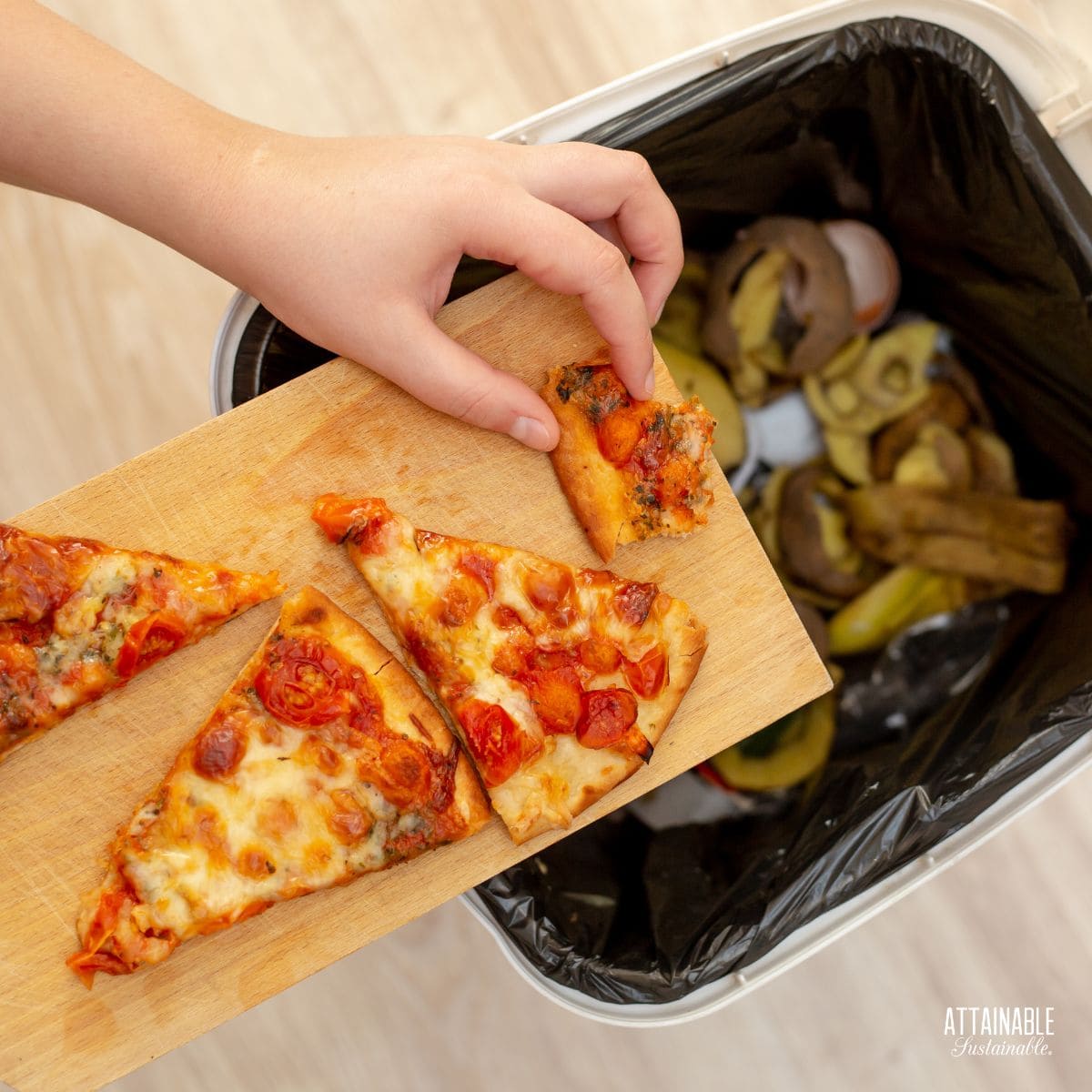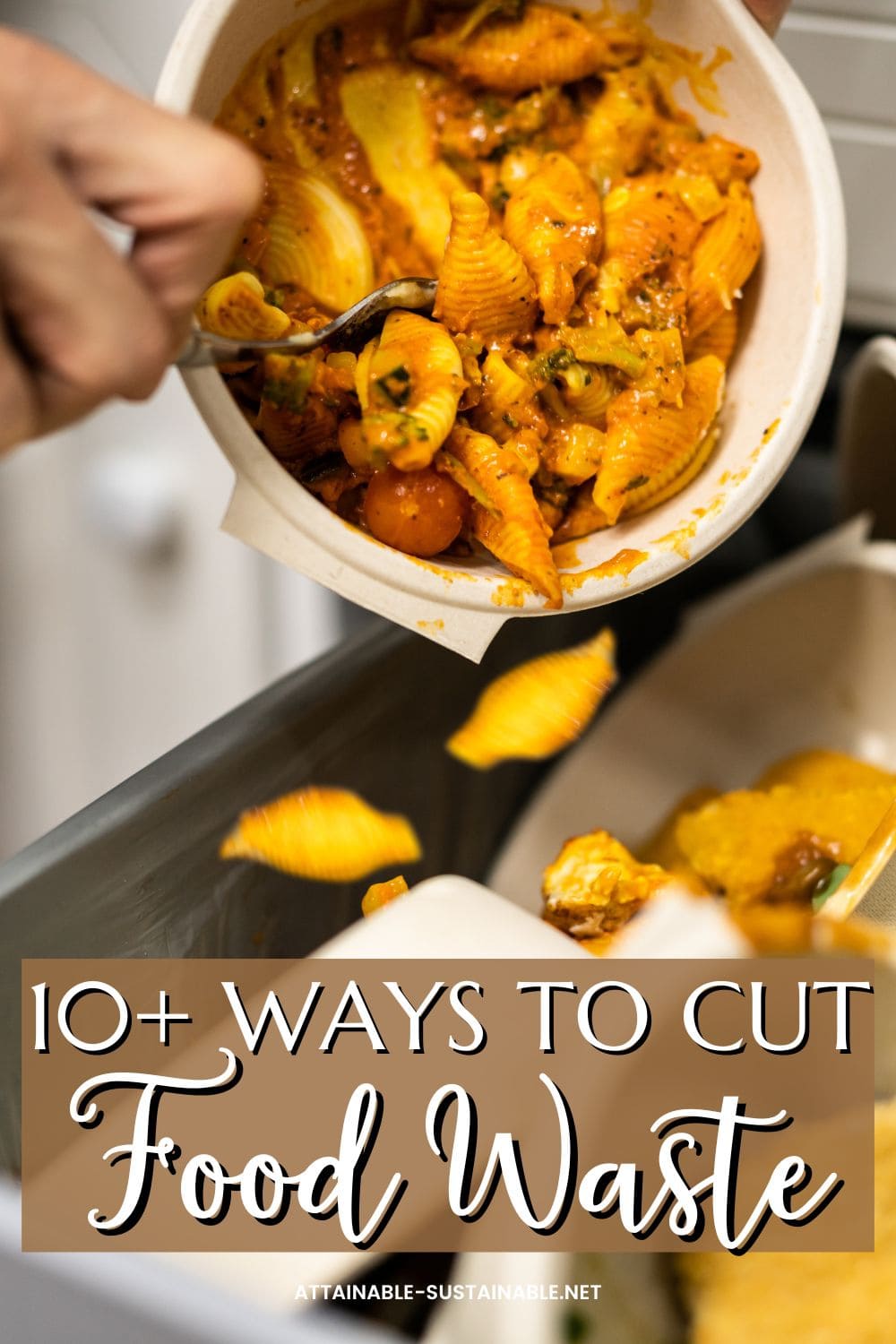That moldy container of…something…at the back of the fridge. The milk that went south. The oversized salad that got soggy. Does this sort of food waste sound familiar?
Originally published June 2013; this post has been updated.
Here’s a stat that might make you consider how to prevent food waste:
According to the UN Food and Agriculture Organization (FAO), every year 1.3 billion tonnes of food is wasted. [link]
From growing produce and raising livestock (whether you do it yourself or trust a farmer to do it) to delivery and preparing meals, the effort, expense, and resources that go into putting food on our tables is enormous.
But I Don’t Have Food Waste!
Yes, I’ve had people tell me that they don’t have food waste because it goes to their compost pile or the chickens. And sure, technically that’s true. Heck, some of us even grow food specifically for our chickens.
Take a Peek Inside My Book!
Get a free excerpt from my book, Attainable Sustainable: The Lost Art of Self-Reliant Living! You’ll also get my free weekly newsletter, complete with recipes, gardening tips, and a little peek at what’s going on around here — both the zany and the mundane.
But that’s different than buying five pounds of spinach in a plastic container at the big box store, using one pound of it, and then finding that it turned all slimy overnight. I have been guilty of this.
It seems a shame to waste the effort, fuel, and materials it took to bring your food to market only to send it to the compost pile or the chickens, doesn’t it?
Save Money at the Checkout
Preventing food waste means saving money, plain and simple. If you spend $2 for a head of lettuce and eat it, your expenditure does what it was meant to do: feed you.
If you spend $2 for a head of lettuce and it ends up in the compost pile, you might as well have composted a couple of Washingtons.
10 Tips to Prevent Food Waste
1. The best food waste solution? Plan ahead!
Shopping for ingredients to create specific meals creates less waste than wantonly choosing items, hoping that you’ll use them before they go bad.
2. Use up your leftovers.
If your family grumbles about having the same meal two nights in a row, get creative. Baked potatoes, pizza, and quesadillas are all great ways to use up leftover bits and bobs.
Top the taters with leftover cooked veggies, use leftover taco fixings on a multi-cultural pizza, or fill a quesadilla with leftover scrambled eggs for a hearty breakfast.
Still not making your way through leftovers? Add a “leftover” night to the weekly menu.
3. First in, first out.
Use up what’s in your refrigerator before you shop, or at the very least, before you serve the fresher items in the fridge.
4. Take only what you can eat.
Instead of heaping your plate with food, take a smaller amount. You can always go back for more.
5. Soup it up.
If you don’t already know how, learn to make a simple chicken stock with that leftover carcass. Use the stock for soup or freeze it for use in other recipes.
You not only prevent food waste with this plan, but you’re adding to your larder – for free!
6. Save it for later.
Freeze items that you don’t think you’ll get to before they go bad (and then remember to use them).
Casseroles and soups, breads and sweets, and many fresh veggies bought in abundance freeze well. You can even stash your overripe bananas in the freezer for making banana bread.
Bonus: Frozen leftovers will come in handy on those too-busy-to-cook nights.
7. Use food that you might be in the habit of throwing away.
- Remember that the greens on your root vegetables are edible, too, as are broccoli stems.
- Tough asparagus stems might not work for the dish you’re preparing, but they’re great for blending into creamed soups.
- Turn stale bread into croutons or breadcrumbs.
- Salvage funky milk by turning it into ricotta cheese.
8. Never use half an onion.
Okay, the chefs in the crowd won’t like that one, but it’s a habit I got into a long time ago. Halves of onions tend to get lost in the fridge and a little extra onion in the spaghetti sauce never hurt anyone.
9. Store your food properly to prevent food waste
A nice airtight container will prevent food from drying out much better than aluminum foil over a bowl.
The Handcrafted Pantry

Ready to DIY your pantry with more wholesome ingredients? Check out my ebook, The Handcrafted Pantry! Filled with delicious recipes for some of your favorite condiments, snacks, and toppings, it’s the guide you need to start skipping packaged products and embrace homemade.
10. Talk to your kids.
If you pack a school lunch, find out what they will really eat (as opposed to what you think they should eat).
Packing an uber-healthy lunch doesn’t do anyone any good if it’s just getting dumped in the trash at school. Sit down and discuss it and come up with a list of options for healthy lunches and snacks.








I dehydrate foods before they go off, freeze for smoothies, cut up veggies and fruit to add to the dog food (2 large Rottweilers who prefer dry food mixed with the veggie/fruit “pudding” I blend)
I live in a condo with a tiny back porch so my compost bucket is itty bitty. There’s never enough room in it for all of our veggie scraps (my husband and I are mostly vegetarian).